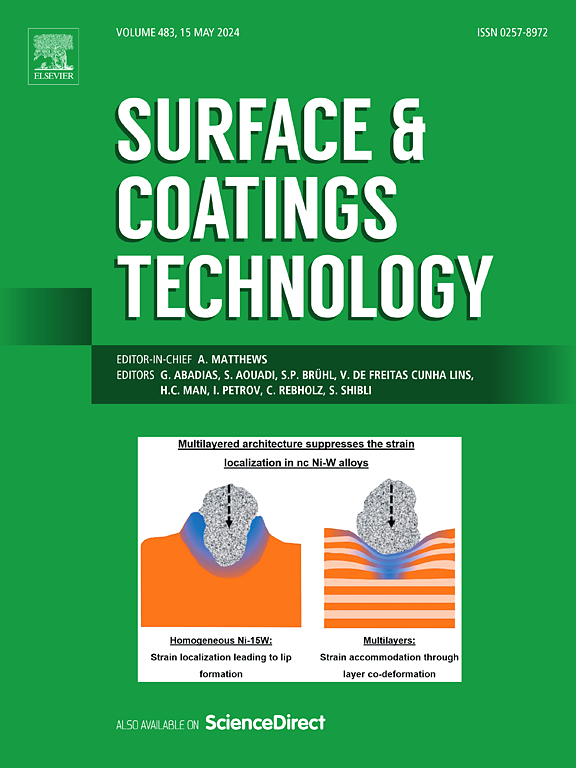Synergetic effect of bias voltage on tribological properties and corrosion behavior of CoCrNiTi medium entropy alloy films deposited by magnetron sputtering
IF 5.3
2区 材料科学
Q1 MATERIALS SCIENCE, COATINGS & FILMS
引用次数: 0
Abstract
CoCrNiTi medium-entropy alloy films (MEAFs) were deposited by direct current (DC) magnetron sputtering under different bias voltages (0 V ~ −150 V). The effects of bias voltages on the microstructure, surface morphology, mechanical properties, wear resistance and corrosion resistance of the film were studied. The results indicate that the CoCrNiTi MEAFs consist of both FCC and amorphous structures. The crystallinity of the film is positively correlated with the bias voltage, while the roughness is negatively correlated. This can be attributed to the bias voltage enhancing both the bombardment and diffusion capabilities of the particles. Due to the grain boundary strengthening caused by the increase of crystallinity, the film exhibits high hardness (11.30 GPa) and toughness at the bias voltage of −150 V. The combination of the highest hardness, toughness, and wear resistance ensures that the film achieves optimal wear resistance with the lowest wear rate (2.55 × 10−4 mm3N−1 m−1) at a bias voltage of −150 V. As the bias voltage increases from 0 V to −150 V, the corrosion potential rises from −0.905 V to −0.542 V, and the corrosion current density decreases from 3.8 × 10−5 A/cm2 to 0.6 × 10−6 A/cm2.
偏置电压对磁控溅射沉积CoCrNiTi介质熵合金膜摩擦学性能和腐蚀行为的协同影响
在不同偏置电压(0 V ~−150 V)下,采用直流磁控溅射法制备了CoCrNiTi中熵合金薄膜。研究了偏置电压对薄膜组织、表面形貌、力学性能、耐磨性和耐腐蚀性的影响。结果表明,CoCrNiTi MEAFs既有FCC结构,也有非晶结构。薄膜的结晶度与偏置电压呈正相关,而粗糙度则呈负相关。这可以归因于偏置电压增强了粒子的轰击和扩散能力。由于结晶度增加导致晶界强化,在−150 V的偏置电压下,薄膜具有较高的硬度(11.30 GPa)和韧性。在- 150 V的偏置电压下,薄膜具有最高的硬度、韧性和耐磨性,具有最低的磨损率(2.55 × 10−4 mm3N−1 m−1)。随着偏置电压从0 V增加到−150 V,腐蚀电位从−0.905 V上升到−0.542 V,腐蚀电流密度从3.8 × 10−5 A/cm2下降到0.6 × 10−6 A/cm2。
本文章由计算机程序翻译,如有差异,请以英文原文为准。
求助全文
约1分钟内获得全文
求助全文
来源期刊

Surface & Coatings Technology
工程技术-材料科学:膜
CiteScore
10.00
自引率
11.10%
发文量
921
审稿时长
19 days
期刊介绍:
Surface and Coatings Technology is an international archival journal publishing scientific papers on significant developments in surface and interface engineering to modify and improve the surface properties of materials for protection in demanding contact conditions or aggressive environments, or for enhanced functional performance. Contributions range from original scientific articles concerned with fundamental and applied aspects of research or direct applications of metallic, inorganic, organic and composite coatings, to invited reviews of current technology in specific areas. Papers submitted to this journal are expected to be in line with the following aspects in processes, and properties/performance:
A. Processes: Physical and chemical vapour deposition techniques, thermal and plasma spraying, surface modification by directed energy techniques such as ion, electron and laser beams, thermo-chemical treatment, wet chemical and electrochemical processes such as plating, sol-gel coating, anodization, plasma electrolytic oxidation, etc., but excluding painting.
B. Properties/performance: friction performance, wear resistance (e.g., abrasion, erosion, fretting, etc), corrosion and oxidation resistance, thermal protection, diffusion resistance, hydrophilicity/hydrophobicity, and properties relevant to smart materials behaviour and enhanced multifunctional performance for environmental, energy and medical applications, but excluding device aspects.
 求助内容:
求助内容: 应助结果提醒方式:
应助结果提醒方式:


